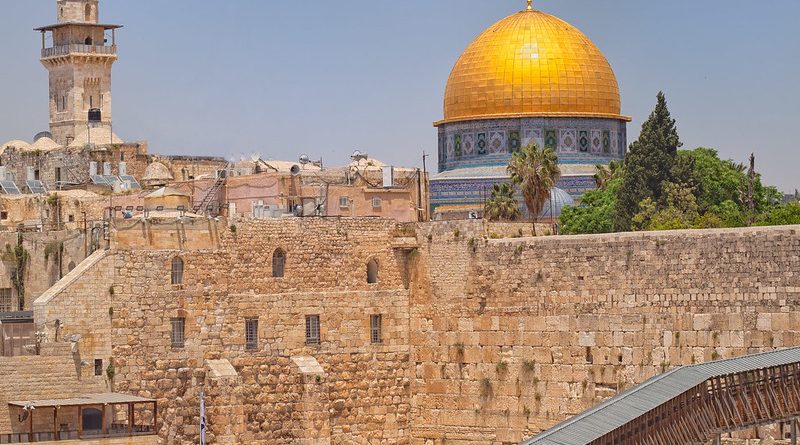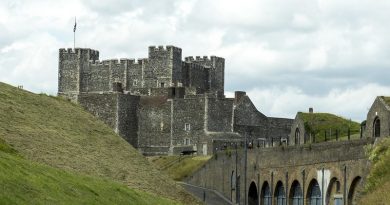Important Historical Sites Of The Moslem Empire
Discover 10 historical sites that made history during the Moslem Empire – and still to this day tell stories of its rules and eventual downfall.
Dome of the Rock, Jerusalem
One of the world’s most significant Holy Sites, the Dome of the Rock is arguably Jerusalem’s most recognisable historical landmark, bearing cultural and religious significance to Jews and Muslims. Its significance to the Jews stems from its construction upon the Foundation Stone, the starting point of the world according to tradition. It bears similar significance to Muslims due to its connection to the earth’s creation. Important religious figures Abraham (Judaism) and Mohammad (Islam) are also closely connected with the site. Built initially in 691 BCE, the Dome of the Rock has repeatedly been destroyed and rebuilt. Its changing architecture reflects the many influences around it, with Byzantine architecture a clear inspiration. It remains one of the oldest and most important examples of Islamic architecture.
Umayyad Mosque, Damascus
Commissioned after the Muslim conquest of Damascus in 634 and completed nearly 100 years later in 715, the Umayyad Mosque, or ‘The Great Mosque of Damascus’, is one of the oldest mosques in the world and one of the most significant. The Umayyad Mosque is considered by Muslims to be Islam’s fourth-holiest site and where Jesus will eventually return in the ‘End of Days’. The Mosque was built on the site of both a former Hellenic temple of Jupiter and a basilica dedicated to John the Baptist, with legend dictating that the Mosque is the location of his severed head. The Great Mosque of Damascus also bears significance as the location of the Mausoleum of Saladin, the first sultan of Egypt and Syria.
Mosque-Cathedral of Cordoba, Cordoba
Arguably the pinnacle of Moorish architecture, the Mosque-Cathedral of Cordoba, located in Andalusia, Spain is a site of controversy and cultural conflict between Christians and Muslims. It is believed that the site was originally a Christian church constructed under Visgothic rule. Following the Muslim conquest of Spain, And al-Rahman I ordered the construction of a Mosque, becoming one of Spain’s most grand Mosques for centuries. However, Ferdinand III of Castile seized control of Cordoba from Muslim rule in 1236 as part of the Reconquista, ushering in a new era of Catholic hegemony over the Iberian region. As a result, the Mosque was converted into a Catholic cathedral. The complex history of the place of worship continues to resonate in modern times. There have been repeated campaigns since the early 21st century to allow Muslims to pray in the cathedral, which have been quashed by Spanish Catholic officials and the Vatican itself.
Horns of Hattin, Palestine
An extinct volcano which bears significance to Muslims as the site of a key conflict during the Crusades-the Battle of Hattin, which saw Saladin defeat Christian forces in 1187. Following this, Saladin is believed to have constructed a temple upon the site, which he called a ‘victory dome.’ Despite this, the site was not long-lasting, falling into ruin by the 13th century. Despite recent excavations, few archaeological remnants remain at the site. Its significance in Muslim history remains important however.
Suleymaniye Mosque, Istanbul
One of the city’s most grand and important sites, the Suleymaniye Mosque is Istanbul’s second-largest. It was constructed between 1550-1557 upon the orders of Sultan Suleyman, the namesake of the Mosque. It is well known for its unique design, which combined Byzantine and Islamic architectural styles. Despite damage incurred from a fire in 1660 and an earthquake in 1766, the Mosque remains intact in the present day and one of Istanbul’s most vaunted holy sites.
Topkapi Palace, Istanbul
Constructed in the 15th Century by Memhed the Conqueror following the conquest of Constantinople, the Topkapi Palace was a highly important site for the Ottoman Empire during the 15th and 16th Centuries, serving as the main administrative centre for the Sultans. Topkapi Palace’s importance began to decline in the 17th Century as new, more illustrious palaces were constructed. In spite of its functional decline, the Topkapi Palace remains one of Istanbul’s most popular landmarks in the present day. After the demise of the Ottoman Empire in 1923, the Turkish government decided to transform the site into a museum. The Topkapi Palace houses a number of treasures and relics, most notably the Spoonmaker’s Diamond. More broadly, the museum presents a detailed archaeological reflection of the Ottoman Empire’s illustrious history and one of its most important historical sites.
Shah Mosque, Isfahan
Constructed between 1611-1629, the Shah Mosque is the most magnificent and enduring relic of Islamic Persian Architecture. The Mosque is the central feature of Naqsh-e Jahan Square, the centre of Isfahan, which was constructed to serve as the base of Shah Abbas, who had just established the city as the Persian Empire’s new capital. The Shah Mosque is known mainly for its immense splendour, its seven-coloured mosaic tiles playing a key role in this. Along with the square in which it is situated, the Shah Mosque remains one of Iran’s most important historical sites today.
Red Fort, Agra
One of the most important Muslim historical sites in India, the Red Fort of Agra was the main hub of the rulers of the Mughal Dynasty for nearly a century. Aside for its distinct, magnificent design, the Red Fort is also known as being the site for a number of battles and conflicts. Shah Jahan, a Muhgal Emperor who oversaw the site’s development, was deposed by his son within the Red Fort in a coup d’ During the time of the Maratha Empire, the Red Fort was seized and lost several times, eventually taken over by the British in 1803. Finally, and perhaps most significantly, the Red Fort served as the backdrop for a key battle during the Indian Rebellion of 1857, which saw British rule over the subcontinent end and independence finally begin.
Tombs of the Sultans, Delhi
The Sultan e Ghari in New Delhi is considered to be the first Islamic Mausoleum in the city, constructed in 1231 for Prince Nasir’d-Din Mahmud, son of Sultan Iltutmish, the Delhi Sultanate’s Third Ruler. Despite this, nobody has been able to identify the bodies which reside in the Mausoleum. The crypt is known for its unusual design, getting its name from the cave in which it is built. The mausoleum has a design influenced by Persian and Oriental architectural styles, reflecting the transition it has gone through over many centuries.
Taj Mahal, Agra
India’s most recognisable and majestic landmark, the Taj Mahal is also the most important relic of the Mughal Empire, built by its emperor Shah Jahan to serve as the tomb for his wife Mumtaz Mahal. The mausoleum was constructed over a 30 year period, taking so long due to the painstaking detail of the structure. The Taj Mahal contains a mosque as well as a guest house. It is almost universally considered to be the most important symbol of Muslim India in addition to being one of the most enduring and widely-admired historical sites on the planet.




